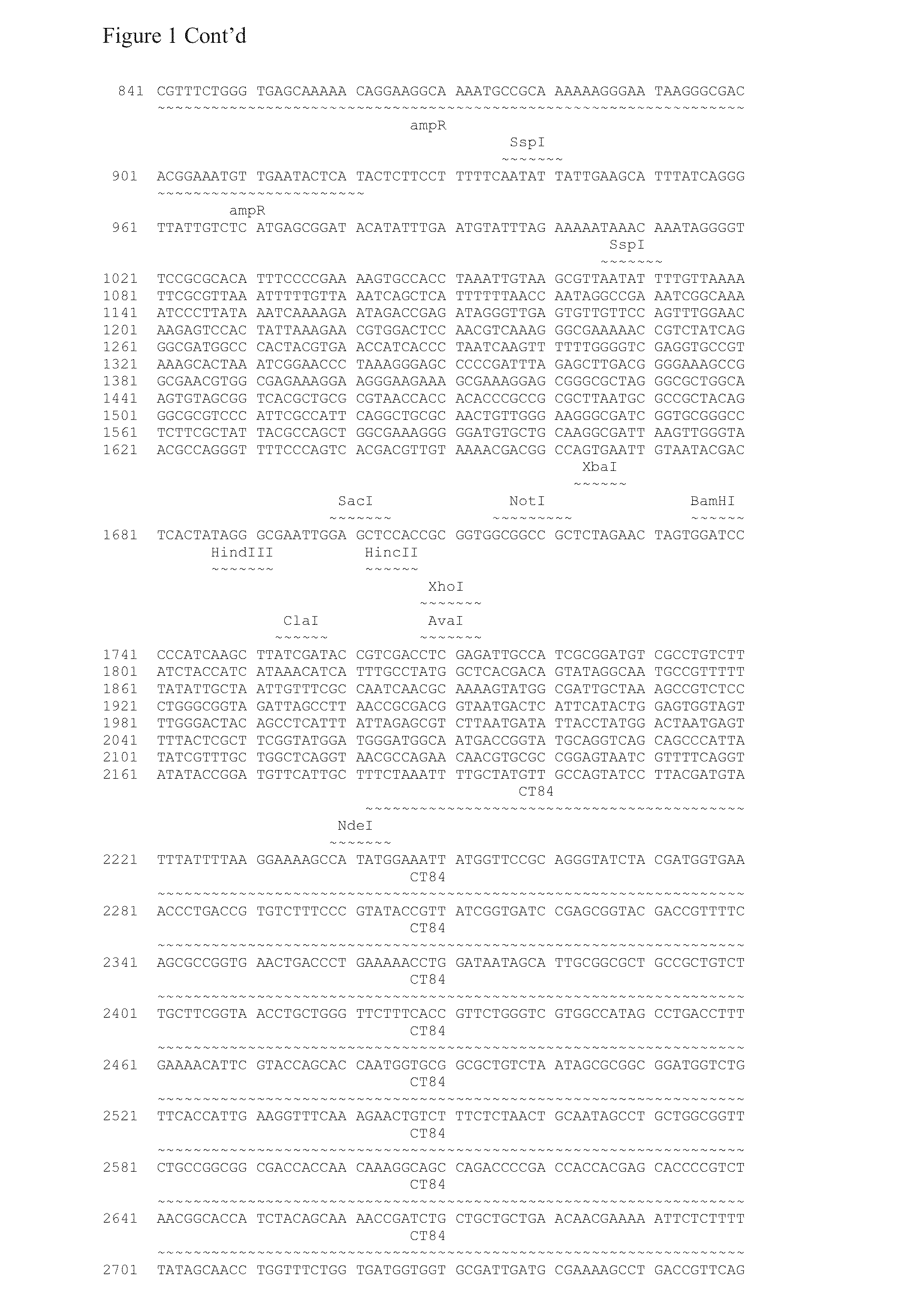Salmonella vectored vaccines against Chlamydia and methods of use
a technology of chlamydia and vector vaccine, which is applied in the field of live salmonella vector vaccine, can solve the problems of limited success and the inability of /i>vaccine to advance into a phase i clinical trial in over 40 years
- Summary
- Abstract
- Description
- Claims
- Application Information
AI Technical Summary
Benefits of technology
Problems solved by technology
Method used
Image
Examples
example 1
Construction of a Salmonella ssaV and aroC Double Mutant
[0158]A Salmonella ssaV and aroC double mutant was constructed as provided in Hindle et al., Infect. Immun.,70(7):3457-3467 (2002). Briefly, wild type S. typhi Ty2 was originally isolated from an individual with typhoid fever in 1916 and has been used for the derivation of all licensed typhoid vaccines. The strain was obtained from the National Collection of Type Cultures (NCTC) (a part of the Public Health Laboratory Service (PHLS) at Colindale, UK). The NCTC prepared the freeze-dried culture in 1982 using nutrient broth as the culture medium. Emergent Product Development UK Limited (then Microscience Ltd) received the strain from NCTC on 3 Jul. 1998 with a certificate of analysis. A vial was re-suspended in liquid broth and streaked onto an agar plate. Inoculum was taken from the plate and cultured in liquid medium overnight. The resulting culture was used for the first step in the construction of the parent strain S. typhi (...
example 2
Introduction of the ssaG-Chlamydia Antigen Promoter-Gene Fusion into the aroC Deletion of S. typhi (Ty2 aroC− ssaV−) ZH9
[0161]A ssaG-Chlamydia antigen gene expression cassette was then inserted in the aroC deletion site. Although constructs were made comprising E. coli codon optimized polynucleotides encoding CT110 and CT84, the cloning strategy can be used with other polynucleotides disclosed herein that encode immunogenic Chlamydia peptides as well as the Chlamydia polynucleotides disclosed in PCT / US08 / 006656, filed May 23, 2008; PCT / US08 / 007490, filed Jun. 16, 2008; U.S. Pat. No. 7,731,980, filed Aug. 1, 2003; U.S. Pat. No. 7,803,388, filed Jul. 20, 2007; U.S. Pat. No. 7,851,609, filed July 20, 2007; U.S. Pat. No. 7,537,772, filed Oct. 2, 2000; U.S. Pat. No. 7,459,524, filed Oct. 2, 1997; U.S. Pat. No. 7,534,445, filed Jan. 27, 2004; PCT / US98 / 20737 (WO 99 / 17741), filed Oct. 1, 1998; U.S. Pat. No. 6,887,843, filed Apr. 3, 2000; U.S. Pat. No. 6,642,023, filed Jul. 6, 2000; U.S. Pat...
example 3
Mouse Genital Infectivity Model
[0170]The modified Salmonella of the invention that express one or more Chlamydia trachomatis antigens (e.g., CT84 or CT110) can be evaluated as immunogens and vaccinogens using the generally accepted mouse C. trachomatis genital infectivity model. For instance, the model can be used to evaluate the constructs as immunogens and for the ability to protect BALB / c mice against challenge with various C. trachomatis serovars (e.g., L2, B, E). The modified Salmonella can be administered to groups of Chlamydia-free animals by three different immunization routes: oral, nasal or subcutaneous. For each route, the immunogenicity of the Salmonella can be determined, either alone or in combination with an appropriate adjuvant. After the first immunization, animals are periodically sacrified and serum IgG and mucosal (cervix / vagina and intestinal sIgA levels determined using known methodologies.
[0171]Six to eight week old (sexually mature), specific-pathogen free, f...
PUM
| Property | Measurement | Unit |
|---|---|---|
| pH | aaaaa | aaaaa |
| pH | aaaaa | aaaaa |
| pH | aaaaa | aaaaa |
Abstract
Description
Claims
Application Information
 Login to View More
Login to View More - R&D
- Intellectual Property
- Life Sciences
- Materials
- Tech Scout
- Unparalleled Data Quality
- Higher Quality Content
- 60% Fewer Hallucinations
Browse by: Latest US Patents, China's latest patents, Technical Efficacy Thesaurus, Application Domain, Technology Topic, Popular Technical Reports.
© 2025 PatSnap. All rights reserved.Legal|Privacy policy|Modern Slavery Act Transparency Statement|Sitemap|About US| Contact US: help@patsnap.com



